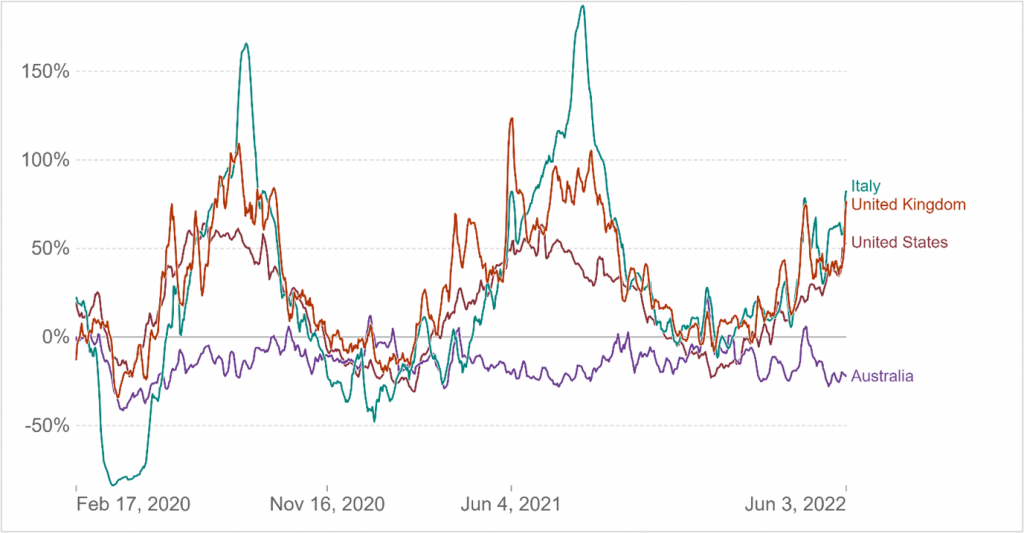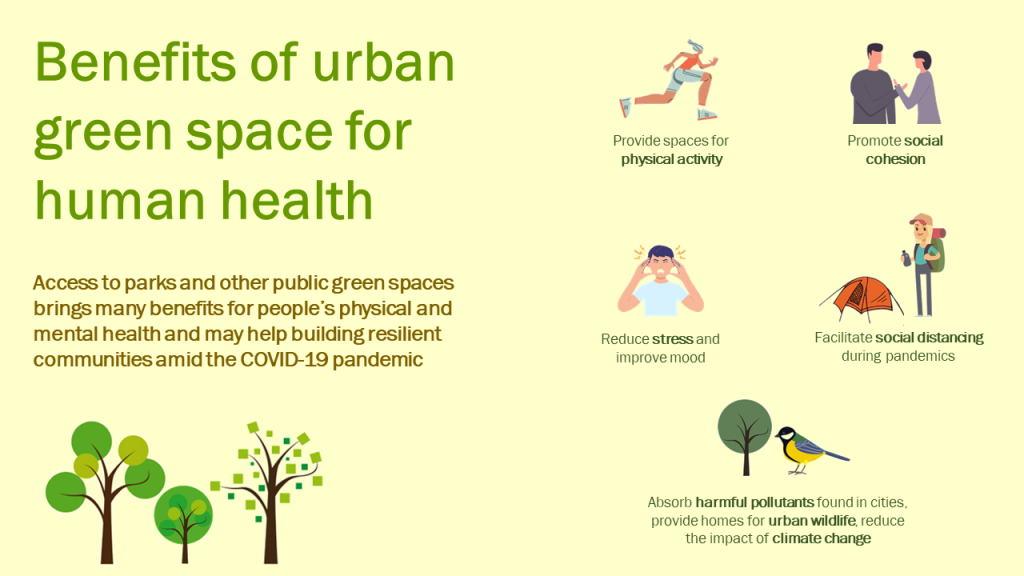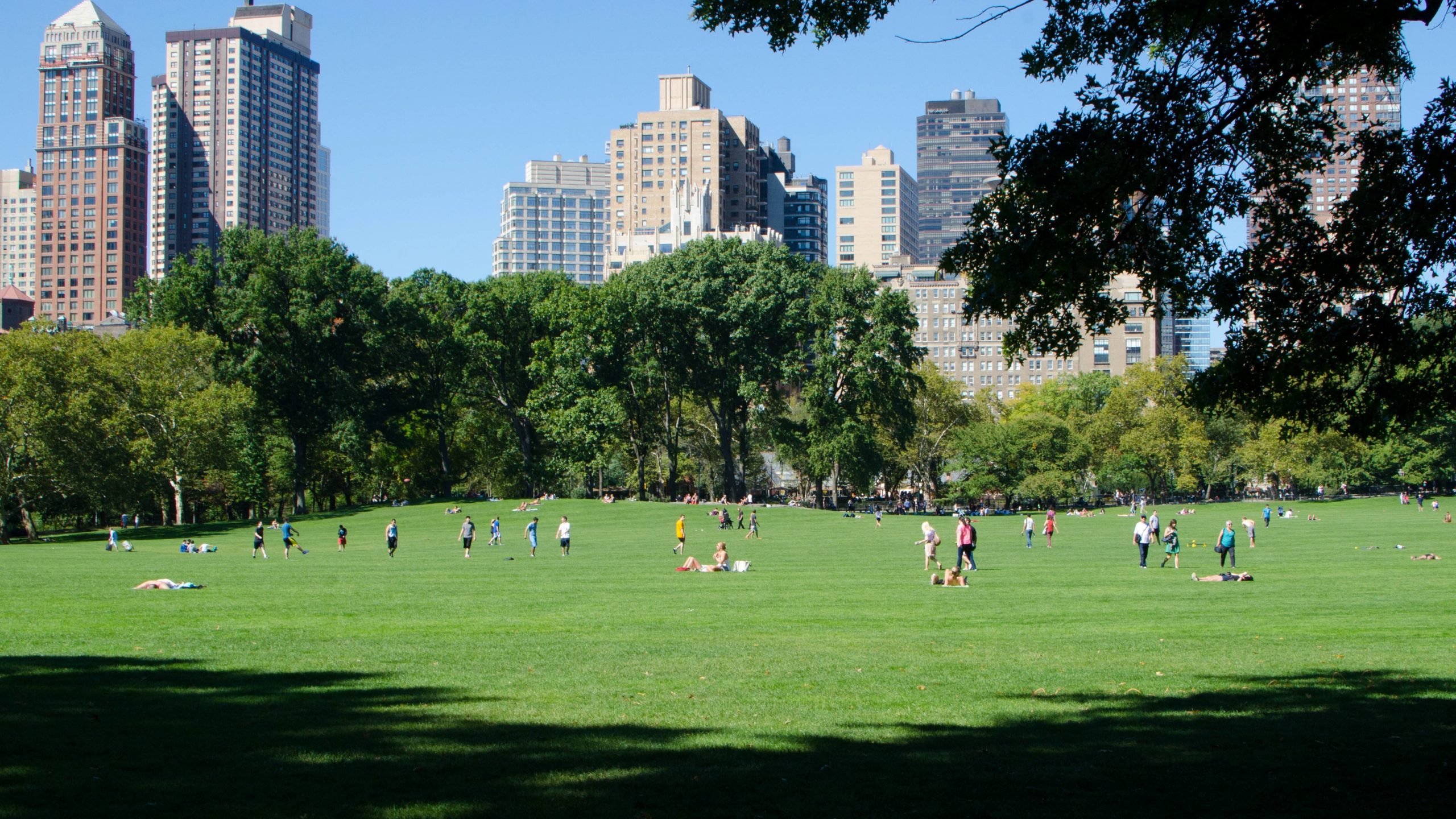COVID-19 Pandemic, social isolation, and mental health
As a response to the COVID-19 outbreak in March 2020, countries across the world took various measures to slow the spread of the virus, including social distancing and lockdown measures, closures of schools and workplaces, and limits on travel. People around the world experienced dramatic disruptions in daily routines and were exposed to several risk factors for psychological distress, including enduring social isolation, loss of income, and increased family stress. According to a Report recently released by the World Health Organization, the COVID-19 pandemic had a severe impact on the mental health and wellbeing of the general population (higher rates of anxiety and depression, increase in unhealthy lifestyles), with negative effects which are likely to be profound and long-lasting.
The use of urban green spaces during Covid-19 pandemic
With the closure of schools, workplaces and indoor leisure facilities (such as gyms, cafes, and restaurants), outdoor green spaces were one of the few recreational places that remained accessible during lockdown periods. However, also due to different levels of restrictions adopted on the use of public spaces during the early phase of the COVID-19 pandemic (e.g., in Italy there was a ban of physical exercise and going outdoors was allowed only for essential reasons), changes in usage patterns varied across cities/countries. Data from Google COVID-19 Community Mobility Trends show variability across countries in the number of visitors to parks and other outdoor spaces (e.g., local parks, national parks, public beaches, marinas, dog parks, plazas, and public gardens) and how the use of green spaces has changed worldwide relative to the period before the pandemic (e.g., Italy, UK, US, Australia; Figure 1).

Change in the use of urban green spaces may depend not only on restrictions but also on individual (e.g., gender, previous usage pattern, socioeconomic status) and green space characteristics. As an example, a recent review has shown that income is related to differential use of green and blue spaces for physical activity, due mainly to access issues. People who live in lower socio-economic areas tend to be more sedentary and have faced greater issues with access to green spaces during pandemic. This observation is of utmost importance if we consider that vulnerable groups and communities (e.g., women, people living in deprived areas, racial and ethnic minority groups) were also the most affected by COVID-19, especially in relation to the economic crisis that followed. Exposure to natural environments has positive physical and mental health benefits (see next paragraph). Hence, keeping parks and green space accessible during COVID-19 and other pandemics is highly recommended in order to promote contact with nature and physical activity in a wide variety of populations – including disadvantaged groups – in urban and suburban settings.
Urban green spaces and health
Interaction with nature is essential to humans and the benefits people derive from accessing outdoor green spaces are now well established in the scientific literature. As shown by a recent umbrella review, green space use is associated with decreased levels of all-cause mortality and improved mental health. Social contacts and physical activity have been proposed as possible mechanisms behind the relationship between green space and health (Figure 2). Supporting the maintenance and access to urban green infrastructure is indeed increasingly recognised as a preventive approach to promote mental and physical health and cope with urban life through stress reduction. Guaranteeing access to green space may also benefit disadvantaged populations, reducing health inequalities and weakening the disproportional effects of the pandemic.
Use of urban green spaces during COVID-19 and its impact on health: a study on Italian twins
In a study exploring the effects of the lockdown on the mental health during the COVID-19 pandemic in Italy (n=20,720), about 12% of the participants reported severe or extremely severe levels of depressive symptoms, 17.6% of anxiety symptoms, and about 41% reported to feel at least moderately stressed. Italian researchers from the Green4C project (F. Cirulli, M. Borgi and B. Collacchi, Istituto Superiore di Sanità), in collaboration with colleagues from the Italian Twin Registry (E. Medda, S. Brescianini), carried out a study to investigate changes in green space use during the COVID-19 pandemic and its impact on mental health in a cohort of Italian twins (n=2,473). Changes in the use of urban green spaces as a result of the pandemic were examined at the individual level. The study investigates not only if participants used green spaces, but also if they used green spaces in new ways and how their behavior (and change in behavior) impacted their mental health. Preliminary results show the impact of the change in the use of green spaces (more free time spent indoors, less time spent in green spaces, preference for solitary activities) on mental health, particularly on stress. This evidence confirms the importance of developing strategies for supporting access to local green space to improve mental and social well-being and healthy lifestyle among the public.

Conclusion: building resilience through green spaces
Although physical isolation and lockdown have represented essential public health measures for containing the spread of COVID-19, they may indirectly represent a threat for the mental health and wellbeing of the general population. In particular, closures of parks and green spaces during the COVID-19 pandemic have limited physical activity and contact with nature, affecting vulnerable populations more than others. The importance of spending time in natural environments and engaging in physical activity regularly, for both physical and mental health, is well established. Moreover, gathering outdoors, even at a safe distance, improves social cohesion and helps people to feel connected to the outside world, thus reinforcing social resilience. This evidence should encourage practitioners and policymakers to give due regard to how they can create, maintain, and improve accessible green spaces in urban contexts, particularly in deprived areas. This is critical in a time of crisis. Indeed, green space use, particularly in urban settings, has the potential to mitigate the wider health effects of the COVID-19 pandemic and support mental health in the general population, ultimately strengthening resilience in the communities. “To unlock the potential of green spaces for human health, it is recommended that they are more explicitly included in public health and spatial planning policies, and that prescribed exposure to green spaces is more often used to complement mental health management in primary care, now and post-covid-19” (Aerts, Vanlessen, and Honnay 2021).
Authors:
Marta Borgi, Barbara Collacchi, Francesca Cirulli (Istituto Superiore di Sanità)
References:
- Aerts R, Vanlessen N, Honnay O. (2021). Exposure to green spaces may strengthen resilience and support mental health in the face of the covid-19 pandemic. BMJ 2021; 373 :n1601. https://doi.org/10.1136/bmj.n1601
- Fiorillo, A., Sampogna, G., Giallonardo, V., Del Vecchio, V., Luciano, M., Albert, U., Carmassi, C., Carrà, G., Cirulli, F., Dell’Osso, B., Nanni, M. G., Pompili, M., Sani, G., Tortorella, A., & Volpe, U. (2020). Effects of the lockdown on the mental health of the general population during the COVID-19 pandemic in Italy: Results from the COMET collaborative network. European psychiatry : the journal of the Association of European Psychiatrists, 63(1), e87. https://doi.org/10.1192/j.eurpsy.2020.89
- Luisa S Flor, L.S., Friedman, J., Spencer, C.N., Cagney, J., Arrieta, A., Herbert, M.E., et al. (2022). Quantifying the effects of the COVID-19 pandemic on gender equality on health, social, and economic indicators: a comprehensive review of data from March, 2020, to September, 2021. The Lancet, 399(10344). https://doi.org/10.1016/S0140-6736(22)00008-3
- Maas, J., van Dillen, S., Verheij, R. A., & Groenewegen, P. P. (2009). Social contacts as a possible mechanism behind the relation between green space and health. Health & place, 15(2), 586–595. https://doi.org/10.1016/j.healthplace.2008.09.006
- Maas, J., Verheij, R. A., Spreeuwenberg, P., & Groenewegen, P. P. (2008). Physical activity as a possible mechanism behind the relationship between green space and health: a multilevel analysis. BMC public health, 8, 206. https://doi.org/10.1186/1471-2458-8-206
- National Center for Immunization and Respiratory Diseases (U.S.). Division of Viral Diseases.;United States. Department of Homeland Security. Cybersecurity and Infrastructure Security Agency (2020). COVID-19 in racial and ethnic minority groups. Series: Coronavirus Disease 2020 (COVID-19) https://stacks.cdc.gov/view/cdc/89820
- Slater, S. J., Christiana, R. W., & Gustat, J. (2020). Recommendations for Keeping Parks and Green Space Accessible for Mental and Physical Health During COVID-19 and Other Pandemics. Preventing chronic disease, 17, E59. https://doi.org/10.5888/pcd17.200204
- Spencer, L. H., Lynch, M., Lawrence, C. L., & Edwards, R. T. (2020). A Scoping Review of How Income Affects Accessing Local Green Space to Engage in Outdoor Physical Activity to Improve Well-Being: Implications for Post-COVID-19. International journal of environmental research and public health, 17(24), 9313. https://doi.org/10.3390/ijerph17249313
- Vandentorren, S., Smaïli, S., Chatignoux, E., Maurel, M., Alleaume, C., Neufcourt, L., et al. (2022). The effect of social deprivation on the dynamic of SARS-CoV-2 infection in France: a population-based analysis. The Lancet, 7(22). https://doi.org/10.1016/S2468-2667(22)00007-X
- WHO (2022), Mental Health and COVID-19: Early evidence of the pandemic’s impact: Scientific brief, 2 March 2022
- Yang, B. Y., Zhao, T., Hu, L. X., Browning, M., Heinrich, J., Dharmage, S. C., Jalaludin, B., Knibbs, L. D., Liu, X. X., Luo, Y. N., James, P., Li, S., Huang, W. Z., Chen, G., Zeng, X. W., Hu, L. W., Yu, Y., & Dong, G. H. (2021). Greenspace and human health: An umbrella review. Innovation (Cambridge (Mass.)), 2(4), 100164. https://doi.org/10.1016/j.xinn.2021.100164
